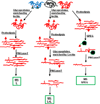Application of glycoproteomics for the discovery of biomarkers in lung cancer
- PMID: 22641610
- PMCID: PMC5321538
- DOI: 10.1002/prca.201100042
Application of glycoproteomics for the discovery of biomarkers in lung cancer
Abstract
Lung cancer is the leading cause of cancer-related deaths in the United States. Approximately 40-60% of lung cancer patients present with locally advanced or metastatic disease at the time of diagnosis. Lung cancer development and progression are a multistep process that is characterized by abnormal gene and protein expressions ultimately leading to phenotypic change. Glycoproteins have long been recognized to play fundamental roles in many physiological and pathological processes, particularly in cancer genesis and progression. In order to improve the survival rate of lung cancer patients, the discovery of early diagnostic and prognostic biomarkers is urgently needed. Herein, we reviewed the recent technological developments of glycoproteomics and published data in the field of glycoprotein biomarkers in lung cancer, and discussed their utility and limitations for the discovery of potential biomarkers in lung cancer. Although numerous papers have already acknowledged the importance of the discovery of cancer biomarkers, the systemic study of glycoproteins in lung cancer using glycoproteomic approaches is still suboptimal. Recent development in the glycoproteomics will provide new platforms for identification of potential protein biomarkers in lung cancers.
© 2012 WILEY-VCH Verlag GmbH & Co. KGaA, Weinheim.
Conflict of interest statement
The authors declare no conflict of interest.
Figures


Similar articles
-
Glycoproteomics using fluid-based specimens in the discovery of lung cancer protein biomarkers: promise and challenge.Proteomics Clin Appl. 2013 Jan;7(1-2):55-69. doi: 10.1002/prca.201200105. Proteomics Clin Appl. 2013. PMID: 23112109 Free PMC article. Review.
-
Pattern identification of lung cancer patients based on body constitution questionnaires (BCQ) and glycoproteomics for precision medicine.Medicine (Baltimore). 2019 Jun;98(24):e16035. doi: 10.1097/MD.0000000000016035. Medicine (Baltimore). 2019. PMID: 31192960 Free PMC article.
-
Large-scale identification of secretome glycoproteins recognized by Wisteria floribunda agglutinin: A glycoproteomic approach to biomarker discovery.Proteomics. 2015 Sep;15(17):2921-33. doi: 10.1002/pmic.201400443. Epub 2015 Jun 11. Proteomics. 2015. PMID: 25921242
-
Glycoproteomics and clinical applications.Proteomics Clin Appl. 2010 Feb;4(2):124-32. doi: 10.1002/prca.200900161. Epub 2009 Dec 9. Proteomics Clin Appl. 2010. PMID: 21137038 Review.
-
[Research Progress of Biomakers Proteomics-based in Lung Cancer].Zhongguo Fei Ai Za Zhi. 2015 Jun;18(6):391-6. doi: 10.3779/j.issn.1009-3419.2015.06.11. Zhongguo Fei Ai Za Zhi. 2015. PMID: 26104898 Free PMC article. Review. Chinese.
Cited by
-
Glycoproteomics using fluid-based specimens in the discovery of lung cancer protein biomarkers: promise and challenge.Proteomics Clin Appl. 2013 Jan;7(1-2):55-69. doi: 10.1002/prca.201200105. Proteomics Clin Appl. 2013. PMID: 23112109 Free PMC article. Review.
-
The utility of a novel triple marker (combination of TTF1, napsin A, and p40) in the subclassification of non-small cell lung cancer.Hum Pathol. 2014 May;45(5):926-34. doi: 10.1016/j.humpath.2014.01.005. Epub 2014 Jan 25. Hum Pathol. 2014. PMID: 24746197 Free PMC article.
-
Glycoproteomic analysis identifies human glycoproteins secreted from HIV latently infected T cells and reveals their presence in HIV+ plasma.Clin Proteomics. 2014 Mar 6;11(1):9. doi: 10.1186/1559-0275-11-9. Clin Proteomics. 2014. PMID: 24597896 Free PMC article.
-
Correlations between the metabolic profile and 18F-FDG-Positron Emission Tomography-Computed Tomography parameters reveal the complexity of the metabolic reprogramming within lung cancer patients.Sci Rep. 2019 Nov 7;9(1):16212. doi: 10.1038/s41598-019-52667-8. Sci Rep. 2019. PMID: 31700108 Free PMC article.
-
Decreased core-fucosylation contributes to malignancy in gastric cancer.PLoS One. 2014 Apr 14;9(4):e94536. doi: 10.1371/journal.pone.0094536. eCollection 2014. PLoS One. 2014. PMID: 24732908 Free PMC article.
References
-
- Jemal A, Siegel R, Xu J, Ward E. Cancer statistics, 2010. CA Cancer J Clin. 2010;60:227–300. - PubMed
-
- Travis WD. IASLC Staging Committee. Reporting lung cancer pathology specimens. Impact of the anticipated 7th Edition TNM classification based on recommendations of the IASLC Staging Committee. Histopathology. 2009;54:3–11. Review. - PubMed
-
- Harpole DH, Herndon JE, Young WG, Wolfe WG, Sabiston DC. Stage I non-small cell lung cancer. Cancer. 1995;76:787–796. - PubMed
-
- Swensen SJ, Jett JR, Hartman TE, Mandrekar SJ, Hillman SL, Sykes AM, Aughenbaugh GL, Bungum AO, Allen KL. CT screening for lung cancer: Five-year prospective experience. Radiology. 2005;235:259–265. - PubMed
Publication types
MeSH terms
Substances
Grants and funding
LinkOut - more resources
Full Text Sources
Medical

